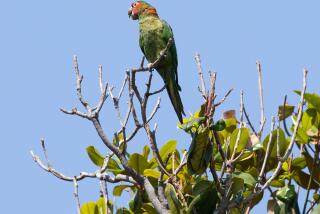Swallow-Seekers Left Waiting in the Wings
- Share via
SAN JUAN CAPISTRANO — It was coming up on noon, Buena Park’s Mexicanisimo dance troupe was onstage, and the line at Las Golondrinas’ food stand stretched half the length of the Mission Capistrano square.
Notably absent: swallows.
But that didn’t particularly bother Anna Cabrera, who drives up with her family every spring from San Clemente for the Return of the Swallows Celebration.
Over the years, the birds have taken a back seat to the festivities anyway, she said, despite organizers’ attempts to woo the birds with clay nesting sites and intentional infestations of ladybugs.
“It’s not as wonderful as it’s been,” said Cabrera, who earlier in the day saw four birds that she thought were swallows atop a light pole. “I’ve been coming here for 12 years and it’s not as crowded. In the older days my family used to come and they would have to have an umbrella so the birds wouldn’t poop on them.”
The festival draws its fame from the thousands of birds that historically return to Mission Capistrano around March 19 after wintering in Argentina. Two years ago, festival organizers opted for a split observation, one on the traditional day, the Catholic Feast of St. Joseph, and the other the weekend before, making it easier for people with weekday commitments to celebrate.
Look at it this way: Thursday is for the birds; this weekend is for the people.
“I just think it’s a real nice experience,” Cabrera said as a ladybug flittered past. “It’s refreshing. I love the building. It just has a different air. It’s so nice.”
Festival organizers said that the first swallow was spotted about 8:20 a.m., and that there were sporadic sightings throughout the day. None, though, were readily seen from the main square anchored Saturday by a stage.
Singer Brenda Von Gremp opened the day’s entertainment with the mission’s version of a national anthem--”When the Swallows Come Back to Capistrano”--that was followed by a mix of mostly Native American and Mexican traditional performances.
The steady crowd of festival-goers, numbering several thousand at any given time, lined food stands and exhibitions as the music and dancing continued on stage. But most also used the day to explore the mission itself, looking at exhibits, inspecting the former living quarters and visiting the church that lies at the heart of the complex.
Batula Bota, 41, and her two children were among nine relatives to make the trip from San Diego. A family of devout Catholics--part of their heritage as Chaldeans, Christians from an area in present-day Iraq--they each made offerings, lighted candles and said silent prayers.
Bota said she came for the swallows, but also for the mission’s original purpose--the church. She likes to visit churches, and Saturday prayed for the health of an ailing relative before returning to the festival.
“If I lived here, I would come every Sunday,” Bota said, the sounds of the festival throbbing softly through the adobe walls into the dark and hushed church, the sweet smell of burning wax in the air. “It is a very spiritual place. I go to many churches. Some people like to go to museums; I like to go to churches.”
More to Read
Sign up for The Wild
We’ll help you find the best places to hike, bike and run, as well as the perfect silent spots for meditation and yoga.
You may occasionally receive promotional content from the Los Angeles Times.







